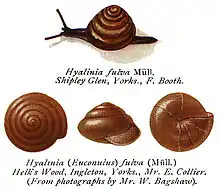Euconulidae
Euconulidae is a taxonomic family of minute, air-breathing land snails, terrestrial pulmonate gastropod mollusks or micromollusks. This land snail family is closely allied to the Zonitidae, the glass snails.
| Euconulidae | |
|---|---|
 | |
| Drawing of a live Euconulus fulvus and its shell | |
| Scientific classification | |
| Kingdom: | |
| Phylum: | |
| Class: | |
| (unranked): | clade Heterobranchia clade Euthyneura clade Panpulmonata clade Eupulmonata clade Stylommatophora informal group Sigmurethra clade limacoid clade |
| Superfamily: | Trochomorphoidea |
| Family: | Euconulidae Baker, 1928 |
Taxonomy
The family Euconulidae was originally placed within the superfamily Gastrodontoidea according to the taxonomy of the Gastropoda (Bouchet & Rocroi, 2005).[1] Since 2017, its classification has been revised and it now belongs to the superfamily Trochomorphoidea [2]
Distribution
The distribution of the Euconulidae includes the Nearctic, the western-Palearctic, the eastern-Palearctic, the Neotropical zone, the Ethiopian zone, Malagasy, south-eastern Asia, Australia, Polynesia and Hawaii.[3]
Shell description
These minute snails have a shell which is roundly conical and broad-based, like the shape of an old-fashioned European woven bee hive or skep. For this reason these snails are sometimes known as "hive snails".
The shells of most Euconulidae are only about 3 mm in size, amber-colored and translucent.
Anatomy
In this family, the number of haploid chromosomes lies between 26 and 30 (according to the values in this table).[4]
Genera
Subfamilies and genera in the family Euconulidae include:
Euconulinae
- Afroconulus Van Mol & van Bruggen, 1971[5]
- Afroguppya de Winter & Bruggen, 1992[5]
- Afropunctum F. Haas, 1934[5]
- Cancelloconus I. Rensch, 1932[5]
- Coneuplecta Möllendorff, 1893[5]
- Diepenheimia Preston, 1913[5]
- Discoconulus Reinhardt, 1883[5]
- Dryachloa F. G. Thompson & H. G. Lee, 1980[5]
- Euconulus Reinhardt, 1883 - type genus of the family Euconulidae[1]
- Guppya Mörch, 1867[5]
- Habroconus Crosse & P. Fischer, 1872[5]
- Kororia H. B. Baker, 1941[5]
- Louisia Godwin-Austen, 1908[5]
- Luchuconulus Pilsbry, 1928[5]
- Palaua H.B. Baker, 1941[5]
- Papuarion Van Mol, 1973[5]
- Parasitala Thiele, 1931[5]
- Sabalimax Tillier & Bouchet, 1989[5]
- Serostena Iredale, 1941[5]
- Turrisitala Iredale, 1933[5]
- Velifera W.G. Binney, 1879[5]
Microcystinae
- Allenoconcha
- Aukena Baker, 1940[6]
- Buffetia
- Cookeana
- Diastole Gude, 1913
- Faunulena
- Greenwoodoconcha
- Hiona Cooke, 1940[6]
- Iredaleoconcha Preston, 1913
- Kaala
- Kusaiea Baker, 1938
- Lamprocystis
- Liardetia
- Mendana
- Microcystis
- Nancibella
- Periclocystis
- Philonesia Sykes, 1900[6]
- Piena
- Pukaloa
- Tengchiena
Cladogram
The following cladogram shows the phylogenic relationships of this family with the other families within the limacoid clade:[3]
| limacoid clade |
| ||||||||||||||||||||||||||||||||||||||||||||||||||||||||||||||||||||||||||||||||||||||||||||||||||||||
References
- Bouchet, Philippe; Rocroi, Jean-Pierre; Frýda, Jiri; Hausdorf, Bernard; Ponder, Winston; Valdés, Ángel & Warén, Anders (2005). "Classification and nomenclator of gastropod families". Malacologia. Hackenheim, Germany: ConchBooks. 47 (1–2): 1–397. ISBN 3-925919-72-4. ISSN 0076-2997.
- Bouchet P., Rocroi J.P., Hausdorf B., Kaim A., Kano Y., Nützel A., Parkhaev P., Schrödl M. & Strong E.E. (2017). Revised classification, nomenclator and typification of gastropod and monoplacophoran families. Malacologia. 61(1-2): 1-526
- Hausdorf B. (2000). "Biogeography of the Limacoidea sensu lato (Gastropoda: Stylommatophora): Vicariance Events and Long-Distance Dispersal". Journal of Biogeography 27(2): 379-390. doi:10.1046/j.1365-2699.2000.00403.x, JSTOR.
- Barker G. M.: Gastropods on Land: Phylogeny, Diversity and Adaptive Morphology. in Barker G. M. (ed.): The biology of terrestrial molluscs. CABI Publishing, Oxon, UK, 2001, ISBN 0-85199-318-4. 1-146, cited pages: 139 and 142.
- MolluscaBase (2018). Euconulinae H.B. Baker, 1928. Accessed through: World Register of Marine Species at: http://marinespecies.org/aphia.php?p=taxdetails&id=994926 on 2018-09-14
- Bouchet P. & Abdou A. (2001). "Recent Extinct Land Snails (Euconulidae) from the Gambier Islands with Remarkable Apertural Barriers". Pacific Science 55(2): 121-127. doi:10.1353/psc.2001.0011.
External links
 Media related to Euconulidae at Wikimedia Commons
Media related to Euconulidae at Wikimedia Commons